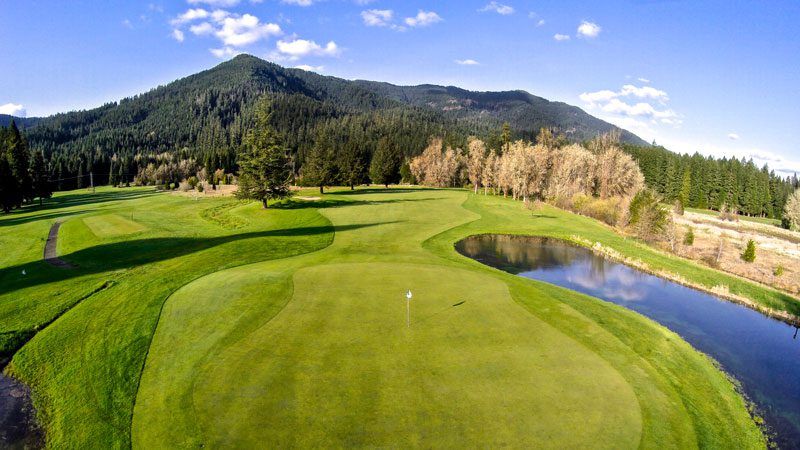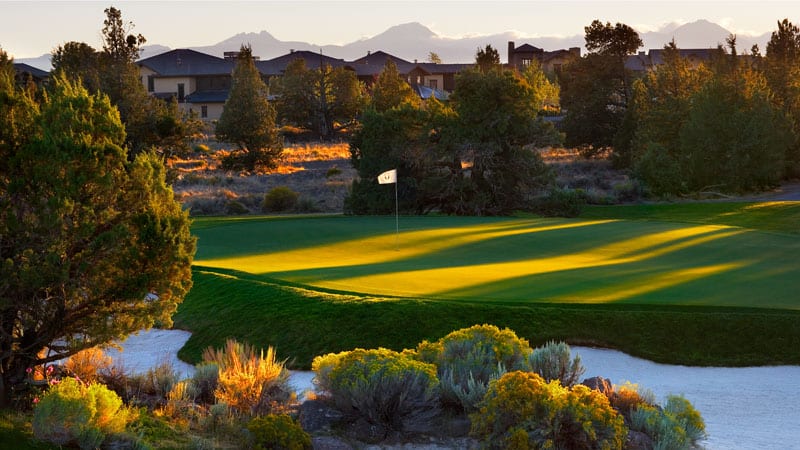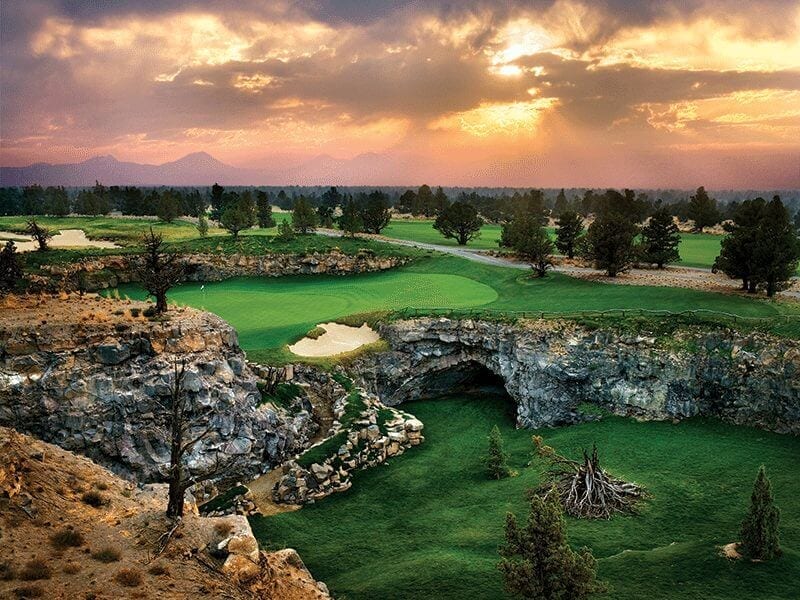Much has changed since the game of golf’s formative days, when shepherds in Scotland would pass long hours by knocking a pebble with a stick at a target, counting strokes along the way. The soul of the game remains true to those simple principles, but most golf these days is a whole lot swankier—not to mention expensive.

So, what would a buddies’ golf trip look like that eschewed all the trappings of modern resort golf? I decided to find out by getting back to basics this past summer with a golf road trip that took my crew off the beaten path. We loaded up my camper trailer and headed east toward Fossil and a rumor of a ghost town golf course. We extended our travels to Condon on the Columbia River plateau on the edge of wheat country. We wrapped up our travels in Seneca (don’t blink or you’ll miss it) where the Bear Valley Golf Course is a place that those swinging shepherds would have recognized for its no-frills approach.
Kinzua Hills Golf Club
Ghost Town Golf
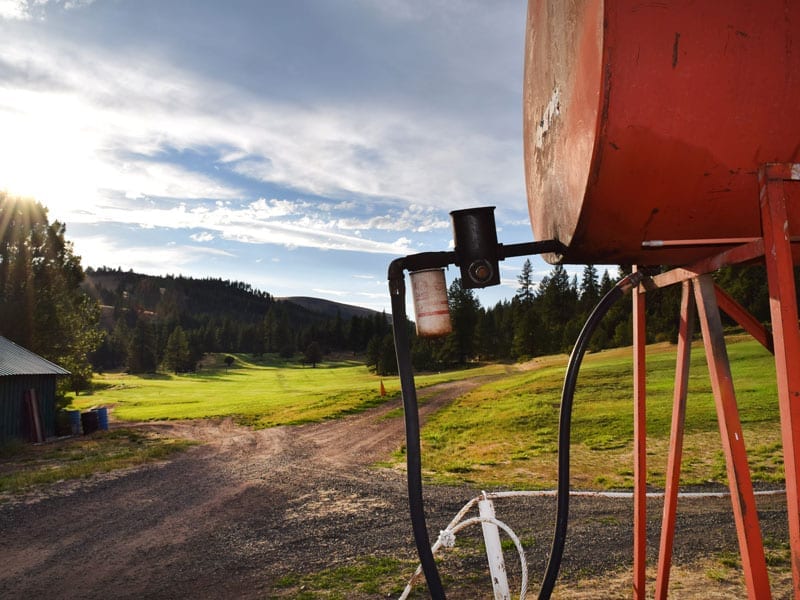
Our first stop was the nearly mythical Kinzua Hills Golf Club, a six-hole course that once served a thriving logging town by the same name. Today the mill is gone, as is all evidence of the town that sprung up around it. Thanks to a local community organization, the Kinzua (pronounced Kin-Zoo) golf course lives on. With onsite camping available, and offered on a donation basis, the Kinzua golf course with its $11 green fee ($1 per hole plus a $5 “trail” fee) might just be the most laissez faire golf experience in Oregon.
From Bend, the drive to Kinzua traces the stunning scenery of the Ochocos east of Prineville and north on Hwy. 207 out of Mitchell through the dramatic John Day River canyon at Service Creek. A small sign about ten miles south of Fossil directs visitors toward Kinzua. We arrived at dusk, following a gravel road and an Apple map that inspired less confidence than my short game. I had read that the Kinzua golf course was taken out in the 1950s to create a baseball field that served as home to a minor league team affiliated with the mill. If that’s true, the calf-straining hills and valleys give no indication of just where a diamond may have been scratched out of the terrain. Luckily for us, the baseball heyday came and went, and the site was returned to a golf course, which it has remained even as the population of the valley plummeted.
After gathering our clubs for a late twilight round, we were greeted by greenskeeper Jerry Luther, who also serves as a caretaker on the site, which includes a clubhouse, complete with full kitchen and dining area that can be rented out for group events. Jerry also serves as a tour guide/caddy of sorts and offered to show us around the course. With his dog, Bear, a spry collie mix on his lap Jerry trailed us around the several holes on his four wheeler while we lugged our golf bags. He pointed out hazards and offered tips on shots and other tidbits of local knowledge. Most importantly Jerry pushed back the start time on the automatic sprinklers, saving us a good dousing.
Like most of the other courses on our pasture golf tour, Kinzua Hills operates on the honor system. Jerry cuts the grass, but he doesn’t count the cash. It’s your job to put the green’s fee in the box that sits on the porch of the clubhouse. If you want a cart to help negotiate those hills, you can talk to Jerry. He’s got a side hustle in rentals. If not, I suggest you lighten your bag a bit, since a full round at Kinzua is three loops around the up-and-down track.
In addition to the playing tips and irrigation assistance, Jerry ensured that the greens were cut down a nearly diabolical speed the following day. (Kinzua is known for its speedy and somewhat tricky green complexes, and Jerry didn’t want us to miss out on the experience). While no scoring records were threatened during our round, we were treated to a stellar sunset that painted Kinzua’s fairways a deep emerald against the red pines and golden rays that filtered through the valley.
We capped the evening with marinated steaks, fresh corn, and scalloped potatoes from a box, around a campfire. Soon a canopy of stars blinked on in the summer sky, the ethereal mist of the Milky Way galaxy stretching overhead. We were missing only a good bottle of single malt to toast a day dedicated to the simple things. We will be back, I’m sure, to raise that glass.
Condon
High Plains Hackers
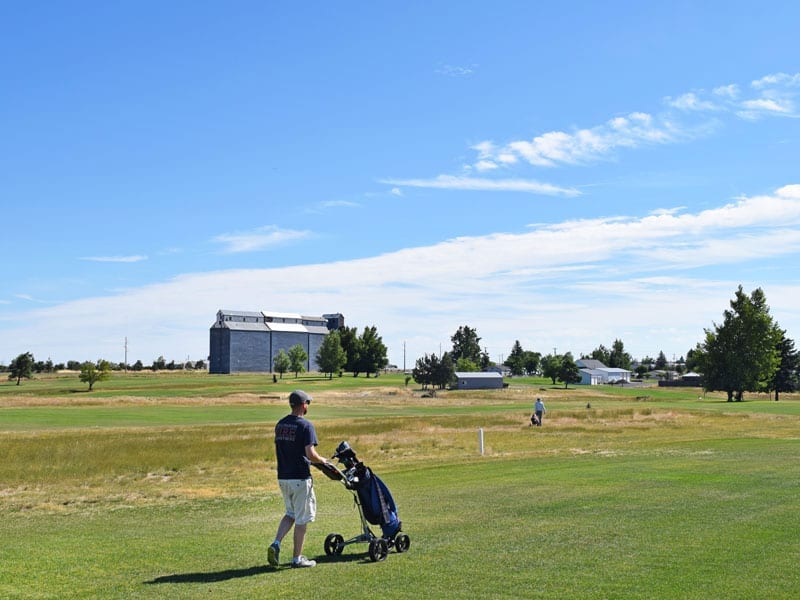
Apart from rural road biking and a revamped historic hotel, there isn’t much to draw visitors to Condon. The nine-hole golf course wasn’t designed to change that. It opened in 1967 for residents of this roughly 600-person town on the edge of the Columbia plateau. Though it’s not clear just how much use it gets from locals or anyone else.
We arrived at the Condon Golf Course to an empty parking lot, which it remained during the duration of our two-hour stay. A kiosk adjacent to a public restroom allowed us to drop our greens fee ($10 for nine holes or $15 all day). A relatively flat course that doesn’t offer much in the way of hazards, the track’s primary defense is wind, which can howl in the afternoon—one of the reasons that the horizon is dotted with wind farms. We timed our round for the morning, before afternoon gusts and heat settled in. The course proved more than enjoyable with sparsely tree-lined fairways that afforded creative recovery shots. The park-style layout makes for a pleasant stroll with a hulking steel-sided grain elevator adjacent to the ninth hole a reminder that wheat, not golf, is king in Gilliam County.
Bear Valley Golf Course
Out to Pasture
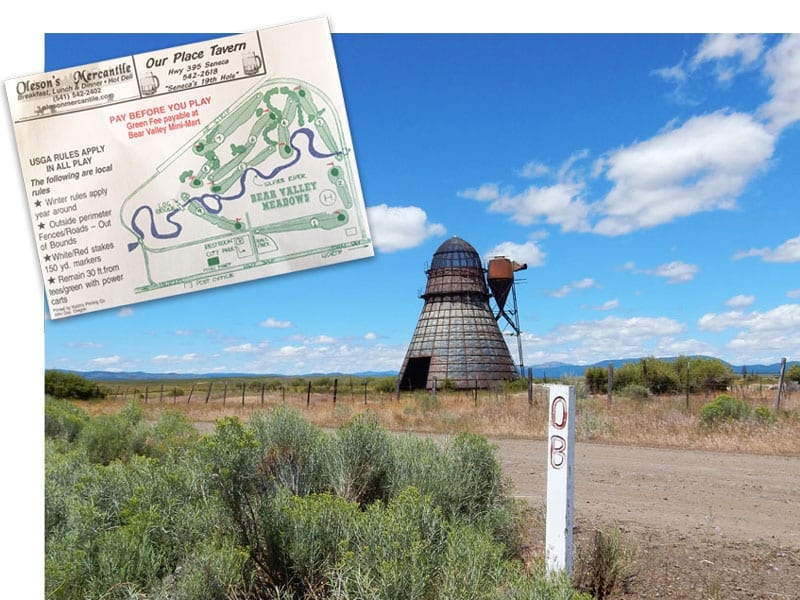
This sparsely maintained golf course in Seneca between Burns and John Day appears on several pasture golf lists and not many other places. The reason for such an omission is somewhat obvious when we arrive at the parking lot at Bear Valley, though parking lot is the wrong term since there is no pavement. (I did however find remnants of pavement on the second fairway which appears to cross an old parking lot).
If honest to goodness pasture golf was what I had set out to find, I hit the jackpot at Bear Valley, where greens as we know them are not part of the package. Instead a few extra passes with the mower through the straw that passes for grass are applied. An enlarged cup like those used for temporary greens on traditional golf courses is employed to counteract the lack of a real putting surface. I wasn’t surprised that I didn’t see any other golfers during my hour and a half round. But the lack of cows, that was a bit puzzling. Still, if you’re in the neighborhood, the price is right at $7, and you won’t have a lot of competition. That’s guaranteed.



